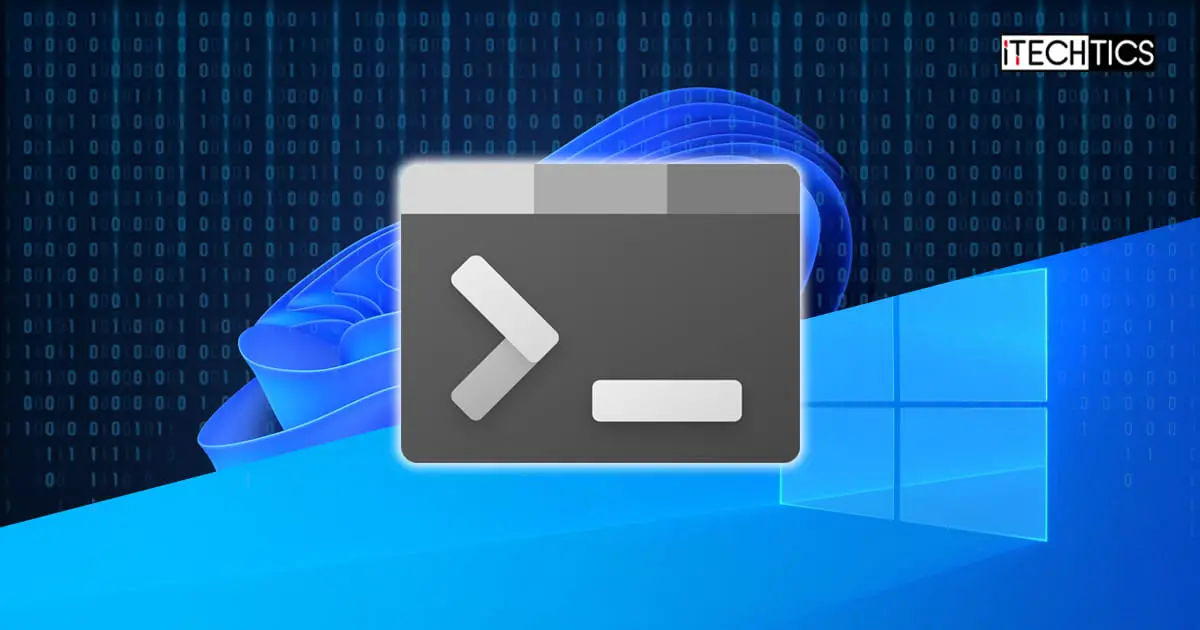Windows Terminal is a new and improved command-line interface available on the Windows 10 and 11 operating systems, which combines your favorite command lines including Command Prompt, PowerShell, and Bash (Windows Subsystem for Linux (WSL)). Not only that, but it also includes other command-line tools like Azure Cloud Shell Connector, SSH, etc.
Other than that, it offers some new features as well. Windows Terminal has multi-tab support, so you do not have to open separate windows for each command line instance.
In this article, we will discuss how to open and operate the Windows Terminal, how you can take advantage of the easy-open option in the context menu, and how to make Windows Terminal the default command-line app.
This page covers
Download and install Windows Terminal
Windows 11 now comes preinstalled with Windows Terminal. However, this does not mean that the legacy command-line tools (PowerShell and Command Prompt) have been replaced just yet. Even though Microsoft plans on replacing these standalone applications, they are still available as of writing this post.
That said, if you are using Windows 10, you won’t find Windows Terminal installed by default. Instead, you will need to download it from Microsoft Store. Use the following guide to download Windows Terminal on Windows 10:
Note: You can also use the following steps to install Windows Terminal on Windows 11 if you accidentally, or deliberately uninstalled it earlier.
-
Open the Windows Terminal Microsoft Store page using any web browser.
-
Click “Get in Store app.”
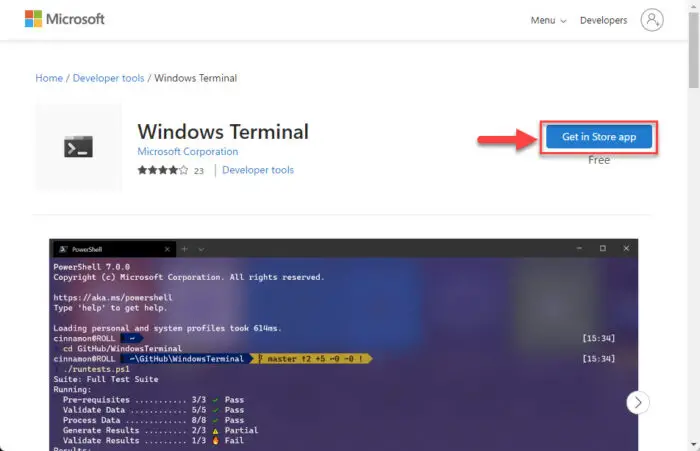
Get Windows Terminal from Microsoft Store -
Allow opening Microsoft Store by clicking “Open Microsoft Store.”
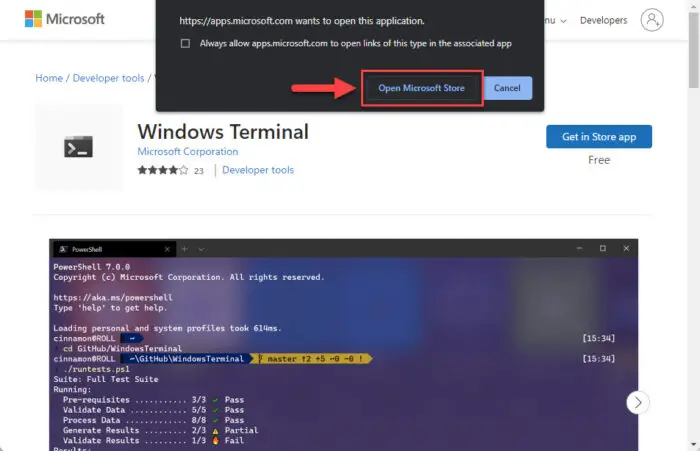
Allow opening Microsoft Store -
Click “Get.”
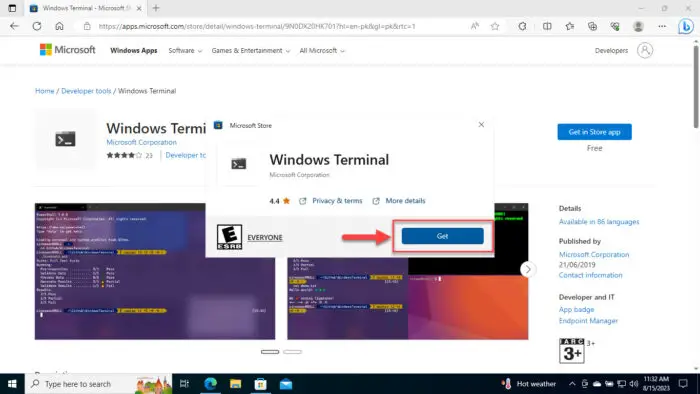
Get Windows Terminal Windows Terminal will now begin downloading and installing
-
When installed, click “Open.”
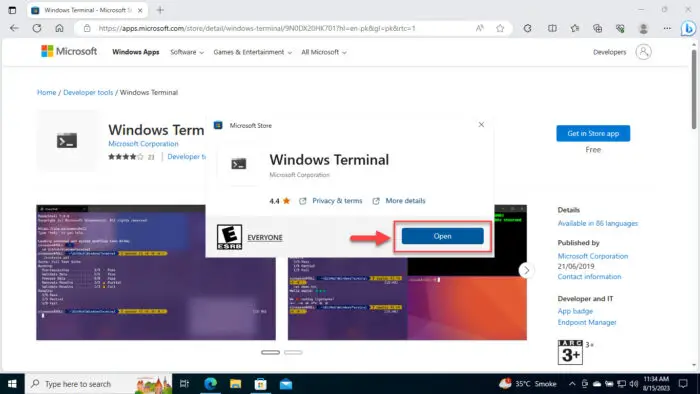
Open Windows Terminal
Windows Terminal will now be installed on your PC (if previously not available). Once installed, continue to learn the many ways to open and access Windows Terminal.
How to open Windows Terminal
The quickest way to open Windows Terminal is from the context menu. The best thing about this method is that you can open the Terminal at any location. This way, you later do not have to provide commands to change the directory.
All you need to do is right-click on a blank space on the desktop or any directory and click “Open in Terminal”.
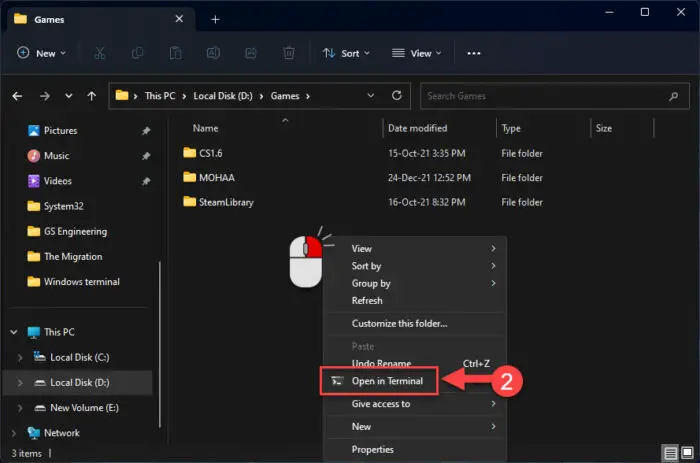
The option to open a Windows terminal inside any directory is available by default on Windows 11. However, it is not true for Windows 10. Even after installing Windows Terminal on Windows 10, the option to open Windows Terminal from the context menu is not added.
You can add this option to open Windows Terminal from the context menu on Windows 10 manually using the method given further down this post.
Open Windows Terminal from Run Command box
Another method to open Windows Terminal is from the Run Command box. This method works on both Windows 10 and 11, as long as the application is installed.
-
Press the Windows Key + R shortcut keys to open the Run Command box.
-
Type in “wt” or “wt.exe” and press Enter.
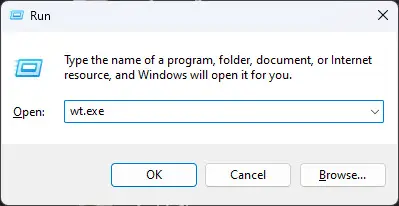
Open Windows Terminal from Run Command box
This will now launch the Windows Terminal.
Another method to open Windows Terminal is by searching for it either from the Start menu or from the search box in the taskbar.
Simply search for “Terminal” and open the highlighted application.
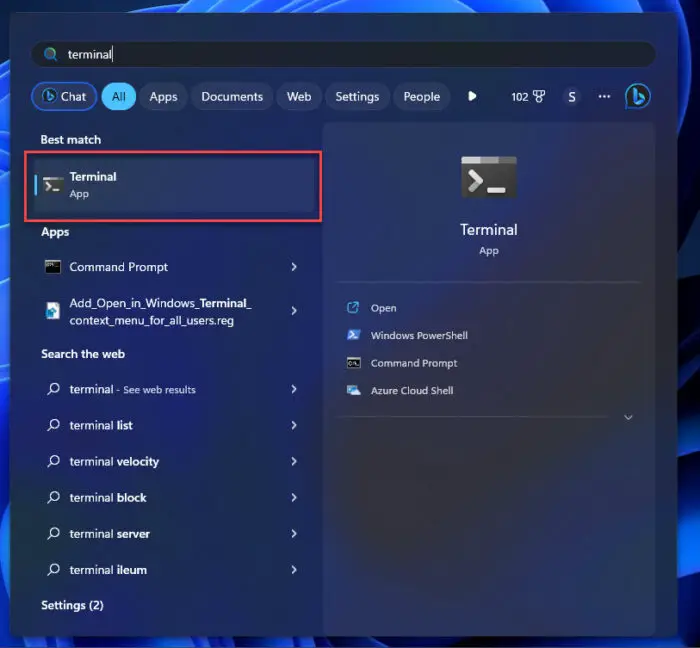
As we mentioned earlier, on Windows 10, you may find the option to open the Windows Terminal from the context menu, even when the app has been installed. Not to worry!
You can add the option to the context menu manually, which will then operate as if it was the real deal.
Note: The method to add or remove the “Open in Terminal” option in the context menu requires making changes in the Windows Registry. Misconfiguration of critical values in the system’s registry could be fatal for your operating system. Therefore, we insist that you create a system restore point or a complete system image backup before proceeding forward with the process.
You can also use our top selection of disk imaging and backup software so you never lose your data or operating system again.
To add the “Open in Terminal” option to the context menu, download the following file by clicking on it, extract the .REG file inside, and execute it. Following prompts to allow the file to run.
 Add Open in Terminal context menu.zip (400 bytes, 78 hits)
Add Open in Terminal context menu.zip (400 bytes, 78 hits)
Once executed, restart the computer for the changes to take effect.
Similarly, if you want to remove the option from the context menu in the future, use this .REG file instead:
 Remove Open in Terminal context menu.zip (400 bytes, 102 hits)
Remove Open in Terminal context menu.zip (400 bytes, 102 hits)
How to make Windows Terminal the default command line
The Windows OS, by default, is set to choose the default command-line application depending on the type of file you are opening. It will usually choose between the Command Prompt and Windows PowerShell when you open a file containing commands. However, there are several ways to change this.
You can set your computer to use Windows Terminal instead of the standalone command-line apps. Below are all the available methods.
Make Terminal the default command line from Settings app
One method is to make the Windows Terminal the default command-line application from the Settings app. Use the steps below to set it as the default app.
Note that this method is also valid for Windows 10 once Windows Terminal has been installed from Microsoft Store.
-
Press the Windows key + i shortcut keys to open the Settings app.
-
Go to the following:
Privacy & security >> For developers
-
Scroll down and expand the drop-down menu in front of “Terminal.”
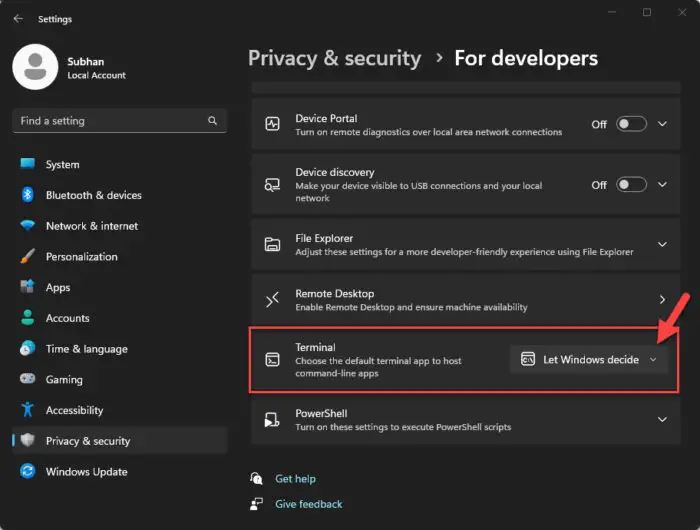
Open Terminal options from Settings -
Select “Windows Terminal.”
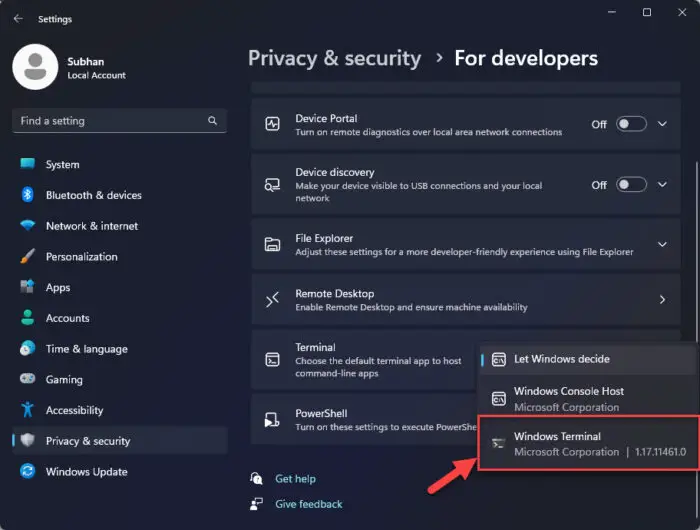
Set Windows Terminal as the default terminal
Make Windows Terminal the default command line from the Terminal
Since the Windows Terminal is a modern command-line tool, it also has built-in settings and preferences which you can configure according to your needs and requirements. Moreover, you can also use the built-in settings in the Terminal to set it as the default command-line tool. Here is how:
-
Open Windows Terminal using one of the methods shared above.
-
Click on the down-arrow button at the top and then click “Settings.” Alternatively, you can use the CTRL + , shortcut keys to open the settings.
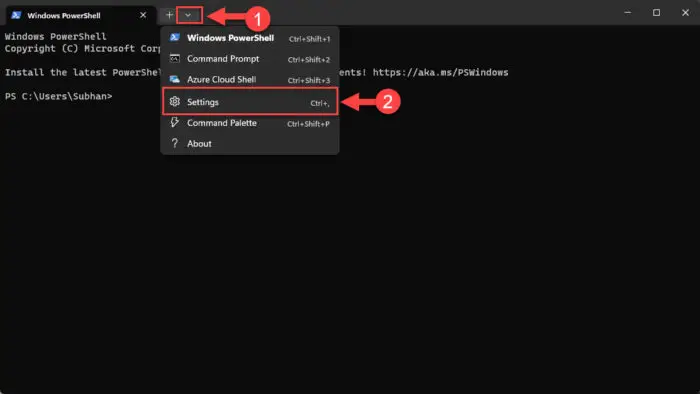
Open Terminal settings -
In the Startup tab, expand the drop-down menu in front of “Default terminal application” and select “Windows Terminal.”
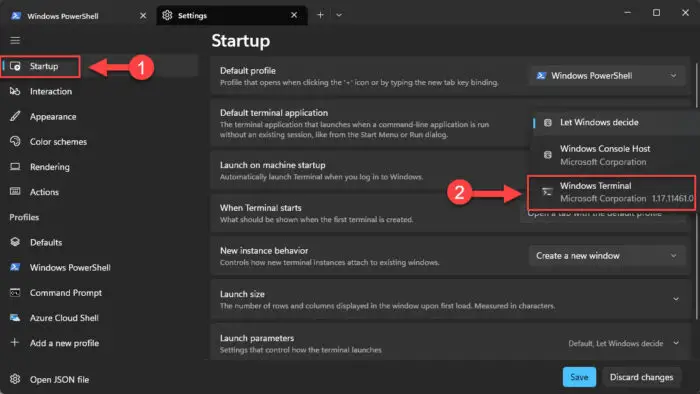
Set Windows Terminal as the default command line app from the Terminal settings -
Click Save for the changes to take effect.
Make Terminal the default command line app from Windows console
When we say “Windows console,” we mean either the Command Prompt or PowerShell. You can also set the Terminal as the default command-line tool directly from these Windows consoles. Here is how:
-
Open either of the Windows consoles.
-
Right-click the top title bar and then click “Properties.”
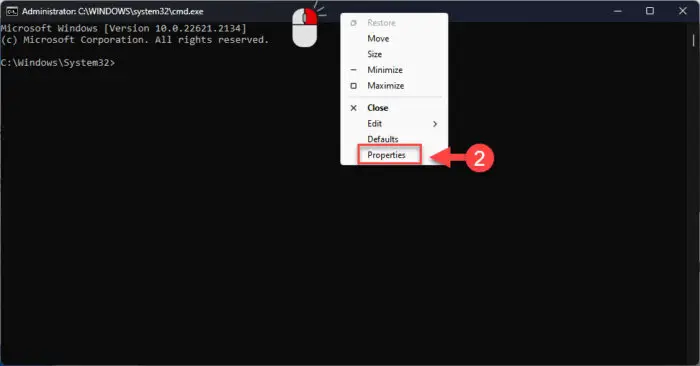
Open Windows console properties -
Switch to the “Terminal” tab.
-
Expand the drop-down menu in the “Default Terminal Application” section and select “Windows Terminal.”
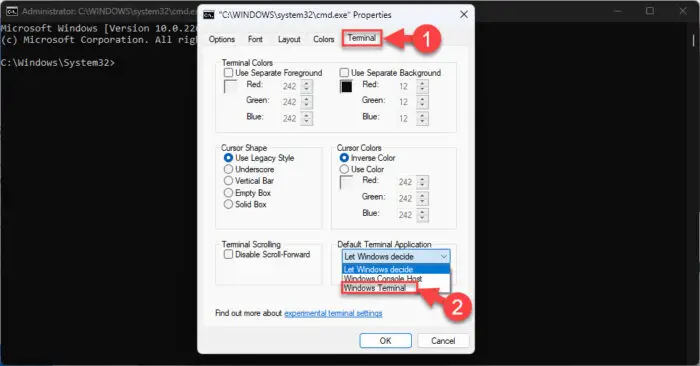
Set Windows Terminal as the default command line app from Windows console preferences -
Click Ok.
This concludes the 3 methods to set Windows Terminal as the default command-line tool on your PC. However, there are more configuration options in the Terminal that you ought to know about.
Set the default Terminal profile
As we mentioned, the Windows Terminal has multiple tools built right into the app. When you open the Terminal, you will notice that, by default, it opens a PowerShell tab. You can change it to a different command-line tool, like the Command Prompt, or the Azure Cloud Shell, so you won’t have to re-open a new tab every time.
This is known as the default profile in Terminal. You can use the following steps to change the default profile in Windows Terminal:
-
Open Windows Terminal using one of the methods shared above.
-
Click on the down-arrow button at the top and then click “Settings.” Alternatively, you can use the CTRL + , shortcut keys to open the settings.

Open Terminal settings -
In the Startup tab, expand the drop-down menu in front of “Default profile” and select the profile that you want to set as default.
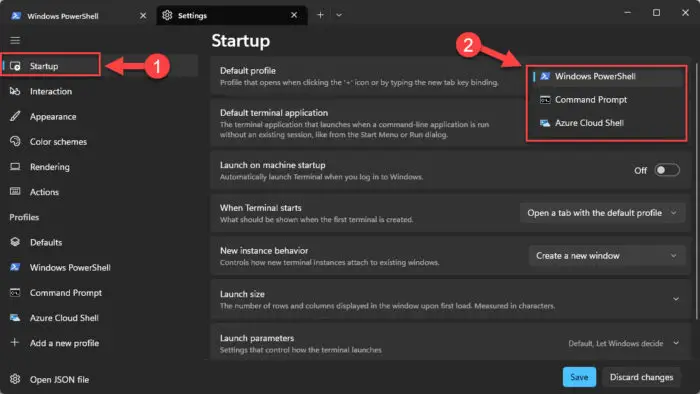
Select the default profile for Windows Terminal -
Click Save for the changes to take effect.
Tab personalization in Windows Terminal
Now that you have learned the basics for the Windows Terminal here is some extra knowledge that you can benefit from.
Windows Terminal offers some extra personalization features that can potentially help you be more productive. These features include using a split-screen within the same tab, renaming the tab, changing the tab’s color, and some other options.
All these options can be found when you right-click on the tab within the Terminal.
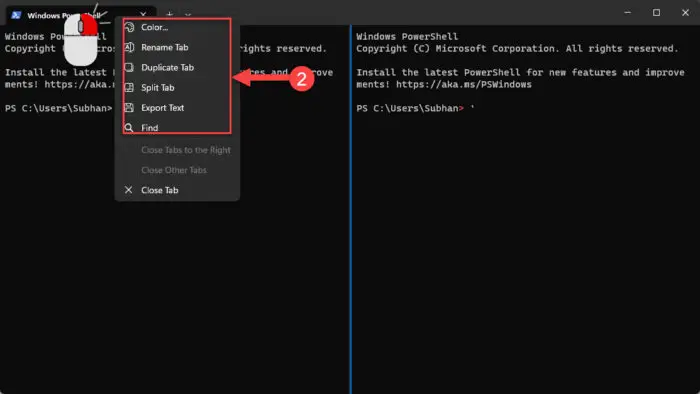
Additionally, you can also find and look for a command or syntax using the “Find” option, or by pressing the CTRL + F shortcut keys.
Conclusion
Windows Terminal is a new and improved, and merged version of the other command-line interfaces within the Windows operating system. Programmers and other people who prefer using different command lines can now benefit from having the combined features under one roof.
If you still find yourself working with Command Prompt and PowerShell, or other supported command-line interfaces, perhaps it is time to shift to Windows Terminal for good.

